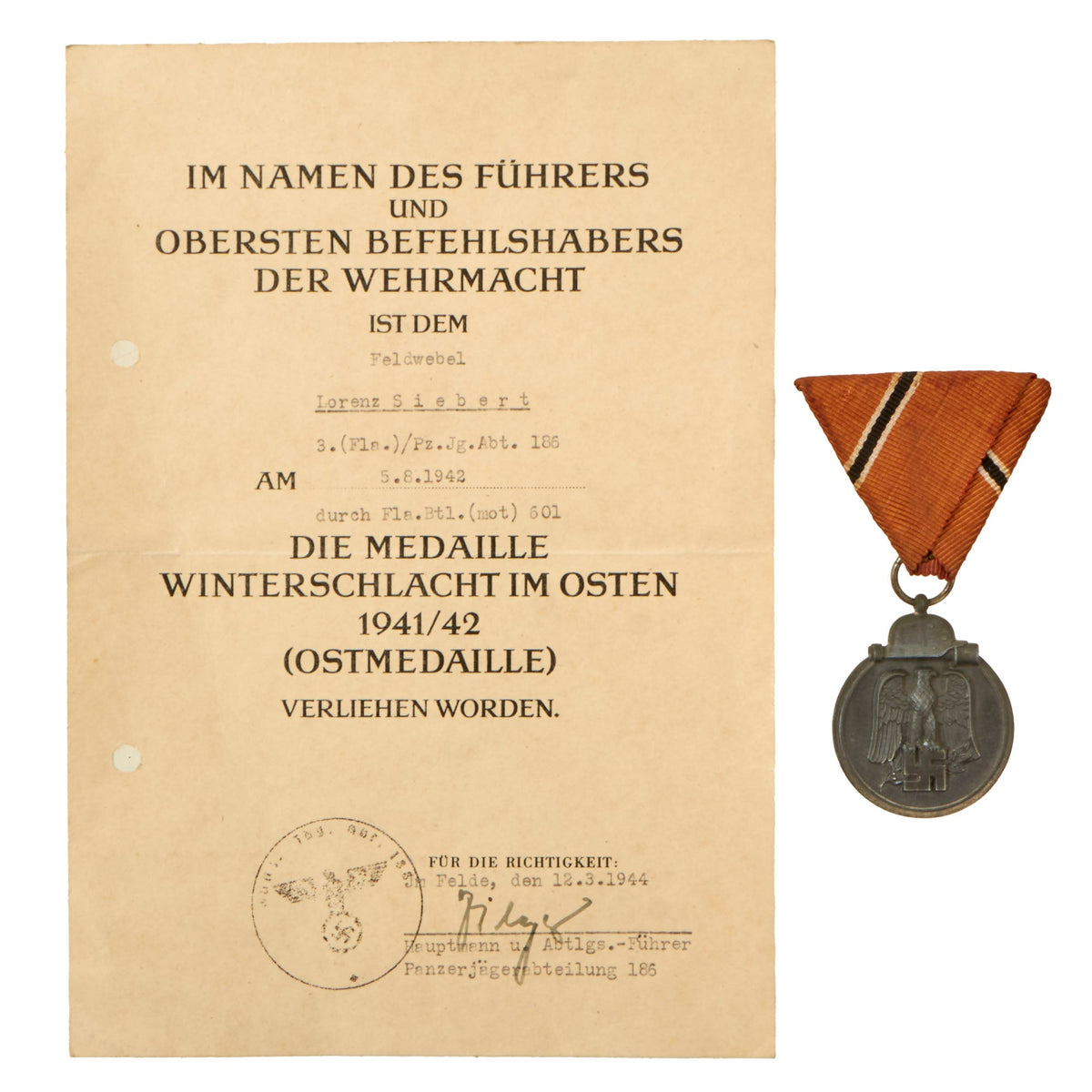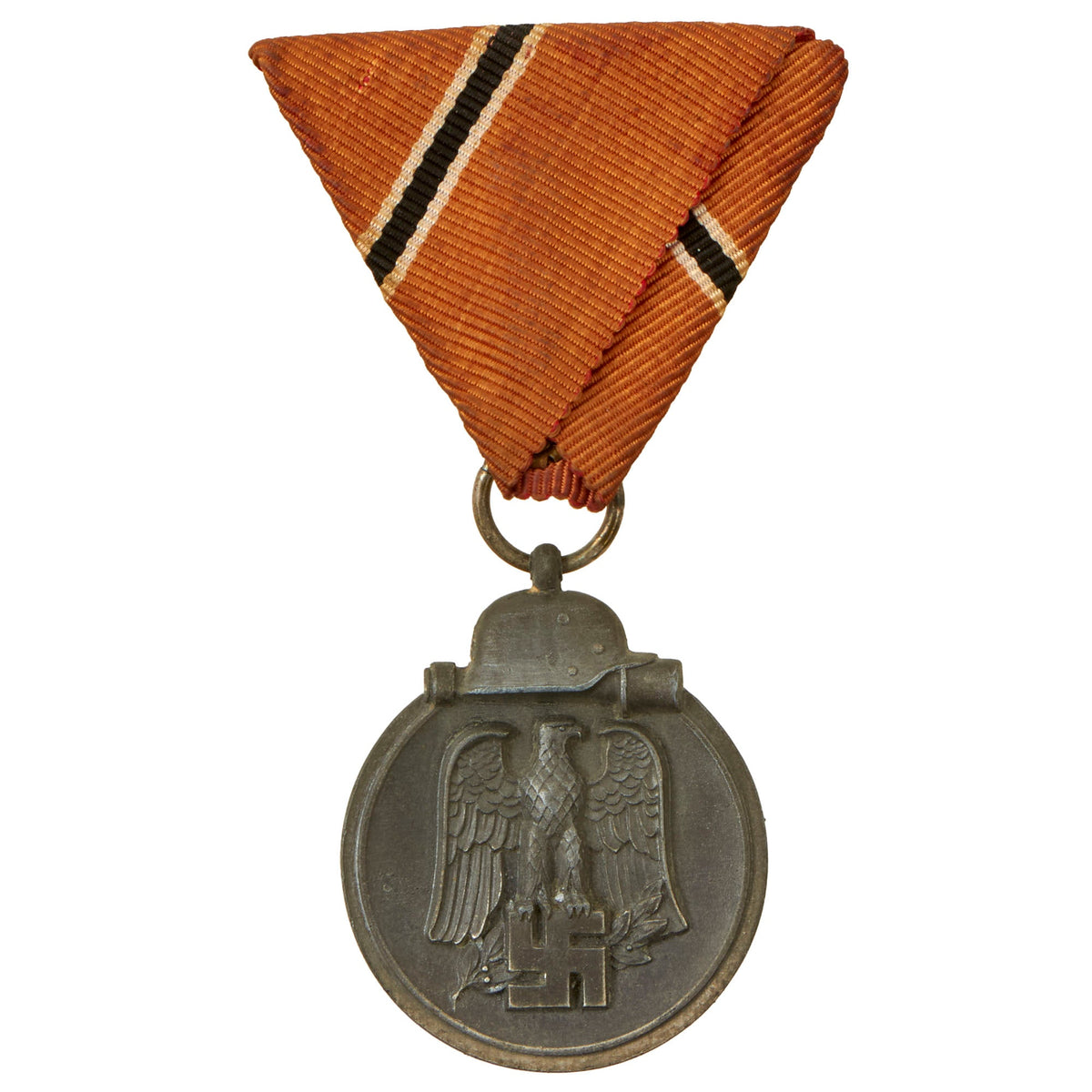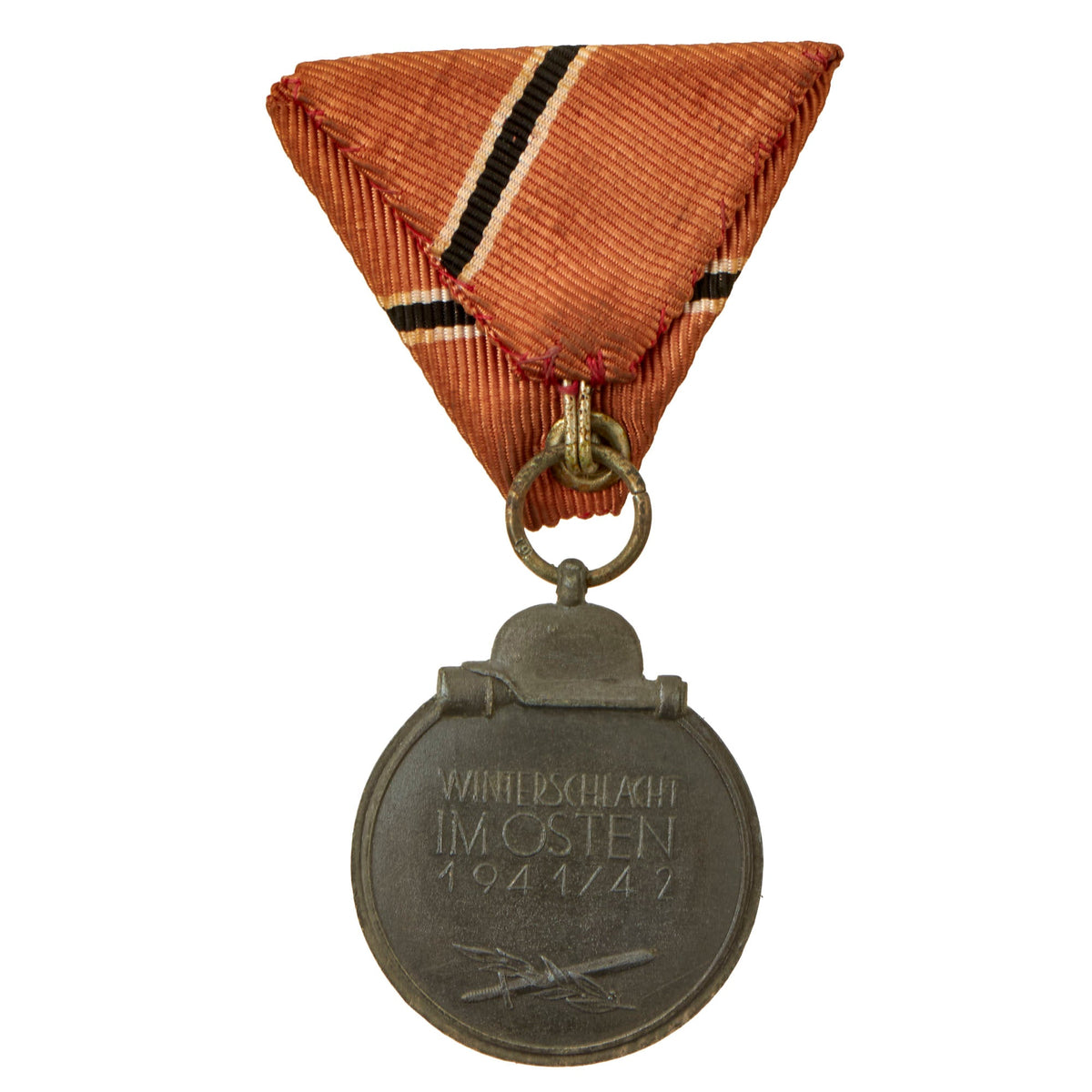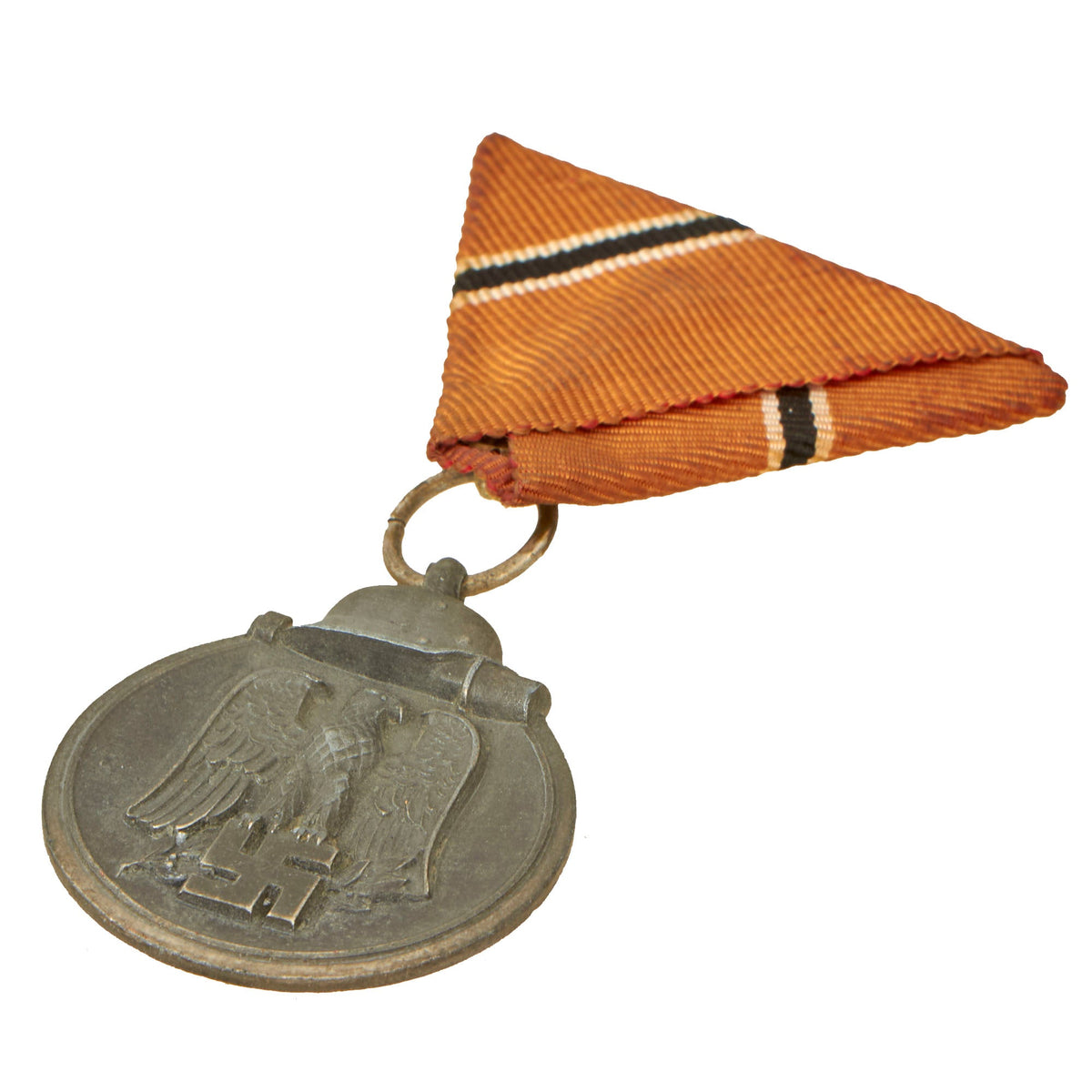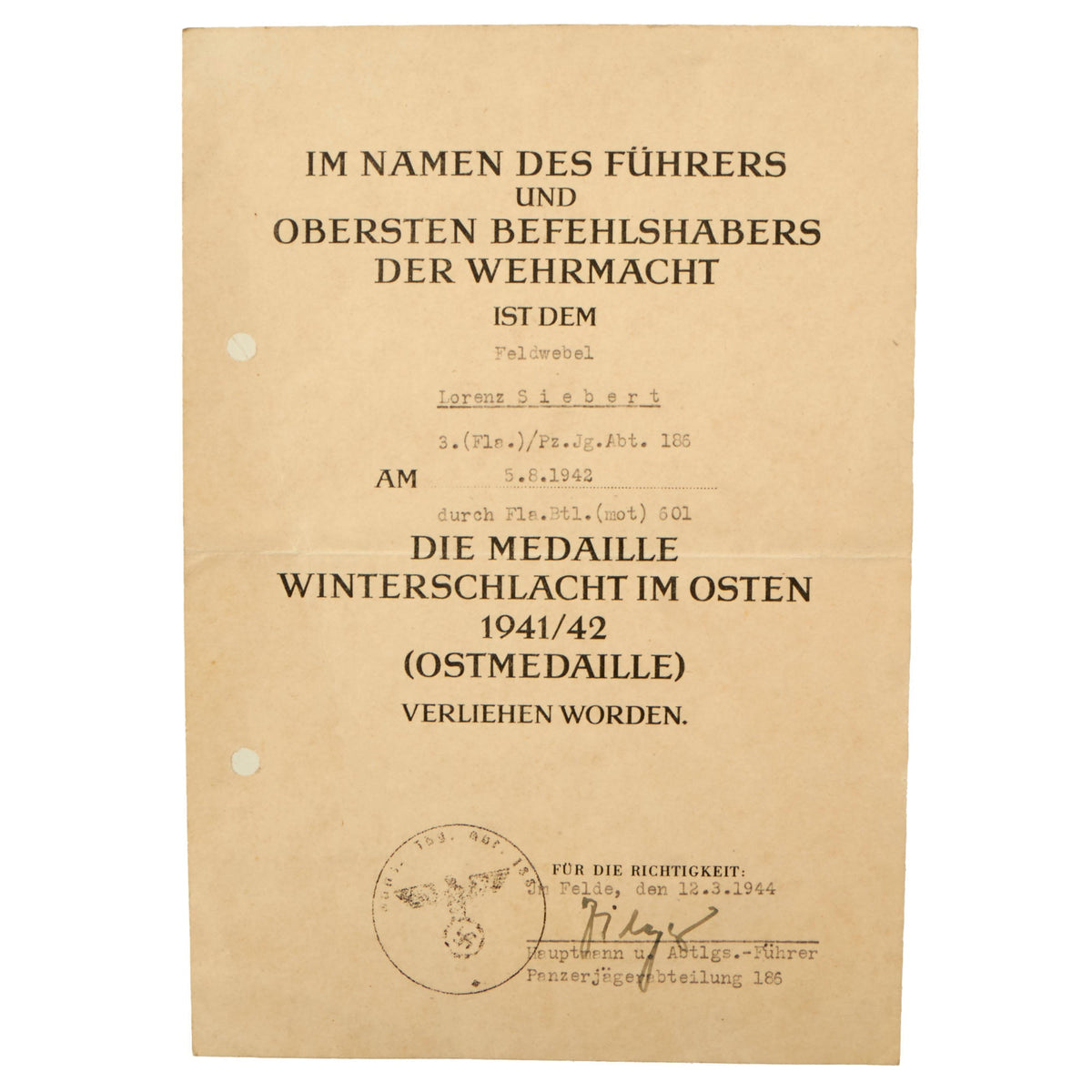Original German WWII Eastern Front Medal with Named Award Document and Austrian Style Ribbon Mount – 186th Panzerjäger Detachment Original Items
$ 395,00 $ 118,50
Original Items: One-of-a-kind. The Eastern Front Medal (German: Medaille Winterschlacht im Osten 1941/42) was a World War II German military decoration awarded to both German and Axis personnel. It was awarded to those who served on the German Eastern Front during the winter campaign period of 15 November 1941 to 15 April 1942. It was instituted on 26 May 1942 and was commonly known as the Ostmedaille (East Medal) or Russian Front Medal.
The medal was wryly called the Frozen Meat Medal or the “Order of the Frozen Flesh” (German: Gefrierfleischorden) by Heer, Luftwaffe and Waffen-SS personnel to whom it was awarded.
This nice example is in very good condition, with a lovely oxidized patina, and is marked with Präsidialkanzlei des Führers Lieferant (Presidential Chancellery Supplier) number 6. on ring, which represents the maker Fritz Zimmermann of Stuttgart, Germany. Most awards that we see are unmarked, so this is a real treat! It comes with an original ribbon, which has been folded and stitched in the “Austrian” style, with a hook that goes through the hanger ring into an eyelet. The ribbon is in good shape, but definitely has had the colors fade, and shows light staining from use. Also included with the medal is the original besittzzeugnis “possession/award” certificate!
The award document indicates that it was awarded to Feldwebel Lorenz S i e b e r t on 5. 8. 1942. Feldwebel (Field Usher) is a Senior NCO rank equivalent to a U.S. Army Technical Sergeant. Siebert is listed as being part of the 3. (Fla.) / Pz.Jg.Abt. 186, which is the abbreviation for 3. (Flugzeugabwehr) / Panzerjäger Abteilung 186, or the 3rd Company (Anti-Aircraft Defense) of the 186th Panzerjäger Detachment. This looks to have been part of the Fla.Btl. (mot) 601, or the 601st Motorized Anti-Aircraft Defense Battalion. The document has the stamp of the Panz. Jäg. Abt. 186, and is signed by the Hauptmann u. Abtlgs.-Führer of the unit. We were not able to find much about this unit, and leave it as an excellent opportunity for further research.
The document has all the correct stamps and markings, and measures about 7 7/8″ x 5 1/2″, (20cm x 14cm), printed on heavy-weight paper with black print and typed in particulars. It is in very good condition, showing minor age toning, and was folded in half at one point.
Overall a very nice set from Germany’s WWII Eastern Front, ready to research and display!
Qualification
Armed service personnel qualified for the badge after a minimum of 14 days served in active combat; 30 combat sorties for Luftwaffe members; 60 days of continuous service in a combat zone; being wounded or suffering a “frozen limb”, severe enough to warrant the issue of a Wound Badge. The medal could be awarded posthumously.
On 20 January 1943, the qualifications for the award changed to include both combatant and non-combatant personnel (including females) in the Wehrmacht. Also, foreign members of Wehrmacht units; personnel killed or missing in action and civilians working in area factories.
Geographic limits were placed on its award of east of Ukraine and Ostland or in the Finland area, east of the original 1940 Russo/Finnish border. It was officially decommissioned by Oberkommando der Wehrmacht on 4 September 1944.
Description
The design of the medal approved for the award was from a contemporary serving soldier, SS-Unterscharführer Ernst Krauit Measuring 3.6 cm (1.4 in) in diameter, of (generally) zinc construction, the medal was given a gun-metal colored coating. The concave obverse side features a national socialist eagle grasping a swas with laurel behind. The reverse features the text in capital letters: “WINTERSCHLACHT IM OSTEN 1941/42” (“Winter Battle in the East 1941/42”) featuring a crossed sword and branch below the text. A helmet and stick grenade below the medal loop as well as outer ring were finished in a polished silver effect. The medal measures approximately 44mm by 36mm.
A ribbon that accompanied the medal featured a central white-black-white (white for snow, black for the fallen soldiers) stripe with red (for blood) either side. The medal and ribbon were presented in a paper packet with the name of the medal on the front and the maker name on the reverse. The medal was officially decommissioned by Oberkommando der Wehrmacht on 4 September 1944.
Like the Iron Cross Second Class (EK2), the medal’s ribbon was to be worn on the second buttonhole of the uniform tunic. As the war progressed, millons of soldiers received the EK2 and those who had received both awards wore the EK2 ribbon in preference to that of the Eastern Front Medal.
Fast Shipping with Professional Packaging
Thanks to our longstanding association with UPS FedEx DHL, and other major international carriers, we are able to provide a range of shipping options. Our warehouse staff is expertly trained and will wrap your products according to our exact and precise specifications. Prior to shipping, your goods will be thoroughly examined and securely secured. We ship to thousands clients each day across multiple countries. This shows how we're dedicated to be the largest retailer on the internet. Warehouses and distribution centres can be located throughout Europe as well as the USA.
Note: Orders with more than one item will be assigned a processing date depending on the item.
Before shipping before shipping, we'll conduct a thorough inspection of the items you have ordered. Today, the majority of orders will be delivered within 48 hours. The delivery time will be between 3-7 days.
Returns
The stock is dynamic and we cannot completely manage it because multiple stakeholders are involved, including our factory and warehouse. So the actual stock may alter at any time. It's possible that you may not receive your order once the order has been made.
Our policy is valid for a period of 30 days. If you don't receive the product within 30 days, we are not able to issue a refund or an exchange.
You can only return an item if it is unused and in the same state as the day you received it. You must have the item in its original packaging.
Related products
Uncategorized
Uncategorized
Uncategorized
Uncategorized
Uncategorized
Uncategorized
Uncategorized
Uncategorized
Uncategorized
Uncategorized
Angolan Rebel 1970s era 60mm Inert Display Mortar from Angolan Civil War Original Items
Uncategorized
Uncategorized
Uncategorized
Uncategorized
Uncategorized
Band of Brothers ORIGINAL GERMAN WWII Le. F.H. 18 10.5cm ARTILLERY PIECE Original Items
Uncategorized
Uncategorized
Uncategorized
Uncategorized
